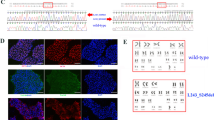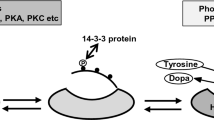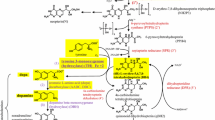Abstract
l-Dopa decarboxylase (DDC) catalyses the decarboxylation of l-Dopa. It has been shown that the DDC gene undergoes alternative splicing within its 5′-untranslated region (UTR), in a tissue-specific manner, generating identical protein products. The employment of two alternative 5′UTRs is thought to be responsible for tissue-specific expression of the human DDC mRNA. In this study, we focused on the investigation of the nature of the mRNA expression in human cell lines of neural and non-neural origin. Our results show the expression of a neural-type DDC mRNA splice variant, lacking exon 3 in all cell lines studied. Co-expression of the full length non-neural DDC mRNA and the neural-type DDC splice variant lacking exon 3 was detected in all cell lines. The alternative DDC protein isoform, Alt-DDC, was detected in SH-SY5Y and HeLa cells. Our findings suggest that the human DDC gene undergoes complex processing, leading to the formation of multiple mRNA isoforms. The study of the significance of this phenomenon of multiple DDC mRNA isoforms could provide us with new information leading to the elucidation of the complex biological pathways that the human enzyme is involved in.




Similar content being viewed by others
References
Voltattorni CB, Minelli A, Vecchini P, Fiori A, Turano C (1979) Purification and characterization of 3,4-dihydroxyphenylalanine decarboxyase from pig kidney. Eur J Biochem 93:181–188
Shirota K, Fujisawa H (1988) Purification and characterization of aromatic l-amino acid decarboxylase from rat kidney and monoclonal antibody to the enzyme. J Neurochem 51:426–434
Ichinose H, Kojima K, Togari A, Kato Y, Parvez S, Parvez H, Nagatsu T (1985) Simple purification of aromatic l-amino acid decarboxylase from human pheochromocytoma using high-performance liquid chromatography. Anal Biochem 150:408–414
Mappouras DG, Stiakakis J, Fragoulis EG (1990) Purification and characterization of l-dopa decarboxylase from human kidney. Mol Cell Biochem 94:147–156
Nishigaki I, Ichinose H, Tamai K, Nagatsu T (1988) Purification of aromatic l-amino acid decarboxylase from bovine brain with a monoclonal antibody. Biochem J 252:331–335
Fragoulis EG, Sekeris CE (1975) Purification and characteristics of DOPA-decarboxylase from the integument of Calliphora vicina larve. Arch Biochem Biophys 168:15–25
Rossetti ZL, Silvia CP, Krajnc D, Neff NH, Hadjiconstantinou M (1990) Aromatic l-amino acid decarboxylase is modulated by D1 dopamine receptors in rat retina. J Neurochem 54:787–791
Rossetti Z, Krajnc D, Neff NH, Hadjiconstantinou M (1989) Modulation of retinal aromatic l-amino acid decarboxylase via alpha 2 adrenoceptors. J Neurochem 52:647–652
Zhu MY, Juorio AV, Paterson IA, Boulton AA (1992) Regulation of aromatic l-amino acid decarboxylase by dopamine receptors in the rat brain. J Neurochem 58:636–641
Hadjiconstantinou M, Wemlinger TA, Sylvia CP, Hubble JP, Neff NH (1993) Aromatic l-amino acid decarboxylase activity of mouse striatum is modulated via dopamine receptors. J Neurochem 60:2175–2180
Zhu MY, Juorio AV, Paterson IA, Boulton AA (1993) Regulation of striatal aromatic l-amino acid decarboxylase: effects of blockade or activation of dopamine receptors. Eur J Pharmacol 238:157–164
Young EA, Neff NH, Hadjiconstantinou M (1993) Evidence for cyclic AMP-mediated increase of aromatic l-amino acid decarboxylase activity in the striatum and midbrain. J Neurochem 60:2331–2333
Young EA, Neff NH, Hadjiconstantinou M (1994) Phorbol ester administration transiently increases aromatic l-amino acid decarboxylase activity of the mouse striatum and midbrain. J Neurochem 63:694–697
Vassiliou AG, Vassilacopoulou D, Fragoulis EG (2005) Purification of an endogenous inhibitor of l-Dopa decarboxylase activity from human serum. Neurochem Res 30:641–649
Vassiliou AG, Fragoulis EG, Vassilacopoulou D (2009) Detection, purification and identification of an endogenous inhibitor of l-Dopa decarboxylase activity from human placenta. Neurochem Res 34:1089–1100
Albert VR, Allen JM, Joh TH (1987) A single gene codes for aromatic l-amino acid decarboxylase in both neuronal and non-neuronal tissues. J. Biol. Chem. 262:9404–9411
Sims KL, Davis GA, Bloom FE (1973) Activities of 3,4-dihydroxy-l-phenylalanine and 5-hydroxy-l-tryptophan decarboxylases in rat brain: assay characteristics and distribution. J Neurochem 20:449–464
Rahman MK, Nagatsu T, Kato T (1981) Aromatic l-amino acid decarboxylase activity in central and peripheral tissues and serum of rats with l-DOPA and l-5-hydroxytryptophan as substrates. Biochem Pharmacol 30:645–649
Siow YL, Dakshinamurti K (1985) Effect of pyridoxine deficiency on aromatic l-amino acid decarboxylase in adult rat brain. Exp Brain Res 59:575–581
O’Malley KL, Harmon S, Moffat M, Uhland-Smith A, Wong S (1995) The human aromatic l-amino acid decarboxylase gene can be alternatively spliced to generate unique protein isoforms. J Neurochem 65:2409–2416
Vassilacopoulou D, Sideris DC, Vassiliou AG, Fragoulis EG (2004) Identification and characterization of a novel form of the human l-dopa decarboxylase mRNA. Neurochem Res 29:1817–1823
Krieger M, Coge F, Gros F, Thibault J (1991) Different mRNAs code for dopa decarboxylase in tissues of neuronal and nonneuronal origin. Proc Natl Acad Sci U S A 88:2161–2165
Kang UJ, Joh TH (1990) Deduced amino acid sequence of bovine aromatic l-amino acid decarboxylase: homology to other decarboxylases. Brain Res Mol Brain Res 8:83–87
Tanaka T, Horio Y, Taketoshi M, Imamura I, Ando-Yamamoto M, Kangawa K, Matsuo H, Kuroda M, Wada H (1989) Molecular cloning and sequencing of a cDNA of rat dopa decarboxylase: partial amino acid homologies with other enzymes synthesizing catecholamines. Proc Natl Acad Sci U S A 86:8142–8146
Siaterli MZ, Vassilacopoulou D, Fragoulis EG (2003) Cloning and expression of human placental l-Dopa decarboxylase. Neurochem Res 28:797–803
Kubovcakova L, Krizanova O, Kvetnansky R (2004) Identification of the aromatic l-amino acid decarboxylase gene expression in various mice tissues and its modulation by immobilization stress in stellate ganglia. Neuroscience 126:375–380
Ichinose H, Sumi-Ichinose C, Ohye T, Hagino Y, Fujita K, Nagatsu T (1992) Tissue-specific alternative splicing of the first exon generates two types of mRNAs in human aromatic l-amino acid decarboxylase. Biochemistry 31:11546–11550
Jahng JW, Wessel TC, Houpt TA, Son JH, Joh TH (1996) Alternate promoters in the rat aromatic l-amino acid decarboxylase gene for neuronal and nonneuronal expression: an in situ hybridization study. J Neurochem 66:14–19
Albert VR, Lee MR, Bolden AH, Wurzburger RJ, Aguanno A (1992) Distinct promoters direct neuronal and nonneuronal expression of rat aromatic l-amino acid decarboxylase. Proc Natl Acad Sci U S A 89:12053–12057
Chang YT, Mues G, Hyland K (1996) Alternative splicing in the coding region of human aromatic l-amino acid decarboxylase mRNA. Neurosci Lett 202:157–160
Djali PK, Dimaline R, Dockray GJ (1998) Novel form of l-aromatic amino acid decarboxylase mRNA in rat antral mucosa. Exp Physiol 83:617–627
Gazdar AF, Helman LJ, Israel MA, Russell EK, Linnoila RI, Mulshine JL, Schuller HM, Park JG (1988) Expression of neuroendocrine cell markers l-dopa decarboxylase, chromogranin A, and dense core granules in human tumors of endocrine and nonendocrine origin. Cancer Res 48:4078–4082
Gilbert J, Haber M, Bordow SB, Marshall GM, Norris MD (1999) Use of tumor-specific gene expression for the differential diagnosis of neuroblastoma from other pediatric small round-cell malignancies. Am J Pathol 155:17–21
Uccella S, Cerutti R, Vigetti D, Furlan D, Oldrini R, Carnevali I, Pelosi G, La Rosa S, Passi A, Capella C (2006) Histidine decarboxylase, DOPA decarboxylase, and vesicular monoamine transporter 2 expression in neuroendocrine tumors: immunohistochemical study and gene expression analysis. J Histochem Cytochem 54:863–875
Vachtenheim J, Novotna H (1997) Expression of the aromatic l-amino acid decarboxylase mRNA in human tumour cell lines of neuroendocrine and neuroectodermal origin. Eur J Cancer 33:2411–2417
Baylin SB, Abeloff MD, Goodwin G, Carney DN, Gazdar AF (1980) Activities of l-dopa decarboxylase and diamine oxidase (histaminase) in human lung cancers and decarboxylase as a marker for small (oat) cell cancer in cell culture. Cancer Res 40:1990–1994
Nagatsu T, Ichinose H, Kojima K, Kameya T, Shimase J, Kodama T, Shimosato Y (1985) Aromatic l-amino acid decarboxylase activities in human lung tissues: comparison between normal lung and lung carcinomas. Biochem Med 34:52–59
Gilbert JA, Bates LA, Ames MM (1995) Elevated aromatic-l-amino acid decarboxylase in human carcinoid tumors. Biochem Pharmacol 50:845–850
Gilbert JA, Frederick LM, Ames MM (2000) The aromatic-l-amino acid decarboxylase inhibitor carbidopa is selectively cytotoxic to human pulmonary carcinoid and small cell lung carcinoma cells. Clin Cancer Res 6:4365–4372
Ichinose H, Kurosawa Y, Titani K, Fujita K, Nagatsu T (1989) Isolation and characterization of a cDNA clone encoding human aromatic l-amino acid decarboxylase. Biochem Biophys Res Commun 164:1024–1030
Sambrook J, Fritsch E, Maniatis T (1989) Molecular cloning: a laboratory manual. Cold Spring Harbor Laboratory Press, NY
Bradford MM (1976) A rapid and sensitive method for the quantitation of microgram quantities of protein utilizing the principle of protein-dye binding. Anal Biochem 72:248–254
Laemmli UK (1970) Cleavage of structural proteins during the assembly of the head of bacteriophage T4. Nature 227:680–685
Towbin H, Staehelin T, Gordon J (1979) Electrophoretic transfer of proteins from polyacrylamide gels to nitrocellulose sheets: procedure and some applications. Proc Natl Acad Sci U S A 76:4350–4354
Batteiger B, Newhall WJt, Jones RB (1982) The use of Tween 20 as a blocking agent in the immunological detection of proteins transferred to nitrocellulose membranes. J Immunol Methods 55:297–307
Baylin SB, Weisburger WR, Eggleston JC, Mendelsohn G, Beaven MA, Abeloff MD, Ettinger DS (1978) Variable content of histaminase, l-dopa decarboxylase and calcitonin in small-cell carcinoma of the lung. Biologic and clinical implications. N Engl J Med 299:105–110
Lloyd K, Hornykiewicz O (1970) Parkinson’s disease: activity of l-dopa decarboxylase in discrete brain regions. Science 170:1212–1213
Park JG, Oie HK, Sugarbaker PH, Henslee JG, Chen TR, Johnson BE, Gazdar A (1987) Characteristics of cell lines established from human colorectal carcinoma. Cancer Res 47:6710–6718
Davis Z, Moertel CG, McIlrath DC (1973) The malignant carcinoid syndrome. Surg Gynecol Obstet 137:637–644
Brown H (1977) Serotonin-producing tumors
Buckland PR, Spurlock G, McGuffin P (1996) Amphetamine and vigabatrin down regulate aromatic l-amino acid decarboxylase mRNA levels. Brain Res Mol Brain Res 35:69–76
Ichinose H, Ohye T, Fujita K, Pantucek F, Lange K, Riederer P, Nagatsu T (1994) Quantification of mRNA of tyrosine hydroxylase and aromatic l-amino acid decarboxylase in the substantia nigra in Parkinson’s disease and schizophrenia. J Neural Transm Park Dis Dement Sect 8:149–158
Sumi-Ichinose C, Hasegawa S, Ichinose H, Sawada H, Kobayashi K, Sakai M, Fujii T, Nomura H, Nomura T, Nagatsu I et al (1995) Analysis of the alternative promoters that regulate tissue-specific expression of human aromatic l-amino acid decarboxylase. J Neurochem 64:514–524
Sumi-Ichinose C, Hasegawa S, Ohtsuki M, Nomura H, Nomura T, Hagino Y, Fujita K, Nagatsu T (1996) Analysis of an alternative promoter that regulates tissue-specific expression of the human aromatic l-amino acid decarboxylase gene in cultured cell lines. J Neural Transm 103:1–15
Moskowitz MA, Wurtman RJ (1975) Catecholamines and neurologic diseases (first of two parts). N Engl J Med 293:274–280
Carlsson A (1988) The current status of the dopamine hypothesis of schizophrenia. Neuropsychopharmacology 1:179–186
Husebye ES, Gebre-Medhin G, Tuomi T, Perheentupa J, Landin-Olsson M, Gustafsson J, Rorsman F, Kampe O (1997) Autoantibodies against aromatic l-amino acid decarboxylase in autoimmune polyendocrine syndrome type I. J Clin Endocrinol Metab 82:147–150
Acknowledgements
This work represents part of the doctoral thesis of Ms Ioanna Chalatsa. This project was partially funded by the EPEAEK2/2003 grant from the Greek Ministry of Education.
Author information
Authors and Affiliations
Corresponding author
Rights and permissions
About this article
Cite this article
Chalatsa, I., Nikolouzou, E., Fragoulis, E.G. et al. l-Dopa decarboxylase expression profile in human cancer cells. Mol Biol Rep 38, 1005–1011 (2011). https://doi.org/10.1007/s11033-010-0196-x
Received:
Accepted:
Published:
Issue Date:
DOI: https://doi.org/10.1007/s11033-010-0196-x




